A Game Theoretic Approach for Energy Sharing in the Italian Renewable Energy Communities
Abstract
:1. Introduction
2. Proposed REC Model
- Self-consumed—It is produced and consumed under the same POD.
- Shared—It is produced by a generator of the community and it is consumed by users of the community connected to different PODs.
- Bought—It is bought from the market if the production of the generators is not enough to satisfy the request of passive users.
2.1. Sets
- M: Members of the community (element i);
- G: Available generators (element j);
- T: Time steps within each single year for which the energy balances are computed (element t);
- Y: Years in the expected lifetime for which the yearly balance is repeated, and the economical flows are evaluated (element y).
2.2. Parameters—Data to Be Provided by the User
- : Reference yearly load profile for user i [kWh];
- : Energy produced by plant j normalized for the rated power [kWh/kW];
- : Relationship between users and generators. 1: user i and generator j are under the same POD. 0: user i and generator j are under different PODs;
- : Reference yearly price profile for the energy sold to the market [€/kWh];
- : Reference yearly price profile for the energy bought from the market [€/kWh];
- : Maximum rated power for generator j;
- : Investment cost for generator j [€/kW];
- : Operational cost for generator j [€/kW/year];
- : Maximum storage capacity [kWh];
- : Minimum Energy to Power Ratio [h];
- : Minimum state of charge of the ESS;
- : Maximum number of cycle for the ESS;
- : Investment cost of the energy storage system [€/kWh] ;
- : Operational cost of the energy storage system [€/kWh];
- : Replacement cost of the energy storage system [€/kWh];
- : Administrative cost for the energy community [€/year];
- : Charge efficiency;
- : Discharge efficiency;
- : Actualization factor;
- : Incentive on shared energy [€/kWh];
- : Expected life of the investments [year];
- : Discount rate or return that could be earned in alternative investments [%];
- : Shared Energy saving index. Saving achieved thanks to energy sharing [€/kWh];
- : Self-Consumption saving index. Saving achieved thanks to self-consumption [€/kWh];
- : Yearly growth of the load [%/year];
- : Yearly growth of the price [%/year];
- : Percentage of the investment expense that can be deduced;
- : Number of years in which the deduction has to be split.
2.3. Variables—Unknown or Changing Parts of the Model
- : Rated power of generator j [kW];
- : Capacity of the centralized energy storage system [kWh];
- : Energy consumed by member i for each year y [kWh]
- : Energy produced by the sum of generators of user i [kWh];
- : Energy self-consumed by user i [kWh];
- : Energy surplus of user i [kWh];
- : Energy deficit of user i [kWh];
- : Energy offered from the members of the community that have a surplus [kWh];
- : Energy required from the members of the community that have a deficit [kWh];
- : Energy shared in real time within the community [kWh];
- : Energy shared within the REC considering also energy provided by the ESS [kWh];
- : Energy bought from the market [kWh];
- : Energy sold to the market [kWh];
- : Energy stored in the ESS at time t (initial instant of the time window) [kWh];
- : Energy withdrawn from the ESS [kWh];
- : Energy injected into the ESS [kWh];
- : Price of the energy sold to the market for each year y [€/kWh];
- : Price of the energy bought from the market for each year y [€/kWh];
- : Investment cost [€];
- : Operational cost [€];
- : Equivalent cost for the energy storage replacement [€];
- : Saving obtained self-consuming/sharing energy [€];
- : Revenues obtained selling the surplus to the market or by mean of the incentives [€];
- : Financial incentives for the community [€].
2.4. Constrains: Single Users Energy Balances
2.5. Constrains: Energy Community Energy Balance
Energy Storage System
2.6. Constrains: Cash Flow Evaluation
2.7. Blocks of Years
2.8. Optimization
3. Game Theoretic Approach for Value Redistribution
3.1. Non-Cooperative Game
3.2. Cooperative Game
3.2.1. The Core
3.2.2. The Shapley Value
- Pareto efficiency: , the total value of the grand coalition is redistributed among the players.
- Symmetry: if then , if two players contribute equally to the coalition, they receive the same payoff.
- Additivity: being v and u value functions of two games, it holds
- Null player: if then , a player that does not contribute to the coalition, receives no payoff.
3.3. Energy Community as a Coalitional Game
3.3.1. The Game
- N is the set of players , where and are respectively the number of generators and passive users participating to the energy community.
- The possible actions for each player are to take part to the community or not (In this planning phase we consider the worst case in which users are not changing their loads to increase the amount of energy shared. In real operation, the same game could become dynamic and users could also apply some demand response schema to maximise their payoff.).
- associates with each coalition a real-valued payoff that the coalition’s members can distribute among themselves. The value generated by coalition S at hour t is defined as:where the energy sold to the market and the energy shared depends on the members of the coalitions S and are obtained from Equations (21) and (23). The presence of each player in the community affects the quantity of energy produced and shared, and consequently the economical value produced. The value should be redistributed among the players depending on their contribution. For convenience, the value function could be evaluated yearly, keeping the results immediately comparable with the cash flow analysis. The yearly value is simply the summation over time of .
3.3.2. Stability and Fairness
3.4. Implementation
4. Case Study
4.1. Users Consumption
Users Power Profiles
- Profile for public lighting. There is only one user to which this profile is assigned. The yearly energy consumption has been spread over the hours of darkness, supposing the public lighting work in an ON/OFF mode.
- Profile for other usages. Sixteen users have been defined. We suppose that these users are mainly offices, small artisans and commercial activities. The profile has been created supposing energy consumption in the working hours of the year. In addition, in this case, an ON/OFF mode is considered, with energy consumption concentrated in the peak time windows of the Italian tariff schema (Fascia 1: from 8 a.m. to 7 p.m. from Monday to Friday, national holidays excluded).
- Profile for not residential usage. Fifteen users have been defined. The profile for public lighting and other usages is subtracted to the power transit in primary substation and the resulting profile is the total consumption of domestic users. This is divided between residential and not residential users. The consumption of non residential users is supposed to the be concentrated on weekends.
- Profiles for residential usage. The remaining part of the consumption profile is distributed among 6 types of families, according to the number of family members and their consumption.
4.2. Sources Availability
4.3. Economical Data
5. Results
5.1. Optimization Results
5.2. Value Distribution
6. Conclusions
Author Contributions
Funding
Acknowledgments
Conflicts of Interest
References
- EU. Directive (EU) 2018/2001 of the European Parliament and of the Council on the promotion of the use of energy from renewable sources. Off. J. Eur. Union 2018, 2018, 82–209. [Google Scholar]
- Moncecchi, M.; Meneghello, S.; Merlo, M. Energy Sharing in Renewable Energy Communities: The Italian Case. In Proceedings of the 2020 55th International Universities Power Engineering Conference (UPEC), Torino, Italy, 1–4 September 2020; pp. 1–6. [Google Scholar] [CrossRef]
- Kunze, C.; Becker, S. Energy Democracy in Europe—A Survey and Outlook; Rosa Luxemburg Foundation Brussels Office: Bruxelles, Belgium, 2014; p. 68. [Google Scholar]
- Wüstenhagen, R.; Wolsink, M.; Bürer, M.J. Social acceptance of renewable energy innovation: An introduction to the concept. Energy Policy 2007, 35, 2683–2691. [Google Scholar] [CrossRef] [Green Version]
- Bauwens, T. What Roles for Energy Cooperatives in the Diffusion of Distributed Generation Technologies? 2013. Available online: https://papers.ssrn.com/sol3/papers.cfm?abstract_id=2382596 (accessed on 19 October 2020).
- Koirala, B.P.; Koliou, E.; Friege, J.; Hakvoort, R.A.; Herder, P.M. Energetic communities for community energy: A review of key issues and trends shaping integrated community energy systems. Renew. Sustain. Energy Rev. 2016, 56, 722–744. [Google Scholar] [CrossRef] [Green Version]
- Candelise, C.; Ruggieri, G. Status and evolution of the community energy sector in Italy. Energies 2020, 13, 1888. [Google Scholar] [CrossRef] [Green Version]
- Repubblica Italiana. LEGGE 28 Febbraio 2020, n. 8. Gazzetta Ufficiale Della Repubblica Italiana. 2020, pp. 32–33. Available online: https://www.gazzettaufficiale.it/eli/id/2020/02/29/20G00021/sg (accessed on 19 October 2020).
- ARERA. Deliberazione 4 Agosto 2020—318/2020/R/EEL. 2020. Available online: https://www.arera.it/it/docs/20/318-20.htm (accessed on 19 October 2020).
- Inês, C.; Guilherme, P.L.; Esther, M.G.; Swantje, G.; Stephen, H.; Lars, H. Regulatory challenges and opportunities for collective renewable energy prosumers in the EU. Energy Policy 2020, 138, 111212. [Google Scholar] [CrossRef]
- Reihani, E.; Siano, P.; Genova, M. A new method for peer-to-peer energy exchange in distribution grids. Energies 2020, 13, 799. [Google Scholar] [CrossRef] [Green Version]
- Liu, N.; Yu, X.; Wang, C.; Li, C.; Ma, L.; Lei, J. Energy-Sharing Model with Price-Based Demand Response for Microgrids of Peer-to-Peer Prosumers. IEEE Trans. Power Syst. 2017, 32, 3569–3583. [Google Scholar] [CrossRef]
- Jiang, A.; Yuan, H.; Li, D. A two-stage optimization approach on the decisions for prosumers and consumers within a community in the Peer-to-peer energy sharing trading. Int. J. Electr. Power Energy Syst. 2021, 125, 106527. [Google Scholar] [CrossRef]
- Cui, S.; Wang, Y.W.; Shi, Y.; Xiao, J.W. An Efficient Peer-to-Peer Energy-Sharing Framework for Numerous Community Prosumers. IEEE Trans. Ind. Inform. 2020, 16, 7402–7412. [Google Scholar] [CrossRef]
- Zafar, R.; Mahmood, A.; Razzaq, S.; Ali, W.; Naeem, U.; Shehzad, K. Prosumer based energy management and sharing in smart grid. Renew. Sustain. Energy Rev. 2018, 82, 1675–1684. [Google Scholar] [CrossRef]
- Kunze, C.; Becker, S. Collective ownership in renewable energy and opportunities for sustainable degrowth. Sustain. Sci. 2015, 10, 425–437. [Google Scholar] [CrossRef]
- Fleischhacker, A.; Lettner, G.; Schwabeneder, D.; Auer, H. Portfolio optimization of energy communities to meet reductions in costs and emissions. Energy 2019, 173, 1092–1105. [Google Scholar] [CrossRef]
- Ghiani, E.; Giordano, A.; Nieddu, A.; Rosetti, L.; Pilo, F. Planning of a Smart Local Energy Community: The Case of Berchidda Municipality (Italy). Energies 2019, 12, 4629. [Google Scholar] [CrossRef] [Green Version]
- Mutani, G.; Todeschi, V.; Tartaglia, A.; Nuvoli, G. Energy Communities in Piedmont Region (IT). The case study in Pinerolo territory. In Proceedings of the 2018 IEEE International Telecommunications Energy Conference (INTELEC), Turin, Italy, 7–11 October 2018; pp. 1–8. [Google Scholar] [CrossRef]
- Myerson, R.B. Game Theory: Analysis of Conflict; Harvard University Press: Cambridge, MA, USA, 2002. [Google Scholar]
- Vytelingum, P.; Voice, T.D.; Ramchurn, S.D.; Rogers, A.; Jennings, N.R. Agent-based micro-storage management for the smart grid. Proc. Int. Jt. Conf. Auton. Agents Multiagent Syst. AAMAS 2010, 1, 39–46. [Google Scholar]
- Weaver, W.W.; Krein, P.T. Game-theoretic control of small-scale power systems. IEEE Trans. Power Deliv. 2009, 24, 1560–1567. [Google Scholar] [CrossRef]
- Maity, I.; Rao, S. Simulation and pricing mechanism analysis of a solar-powered electrical microgrid. IEEE Syst. J. 2010, 4, 275–284. [Google Scholar] [CrossRef]
- Tushar, W.; Yuen, C.; Smith, D.B.; Poor, H.V. Price Discrimination for Energy Trading in Smart Grid: A Game Theoretic Approach. IEEE Trans. Smart Grid 2017, 8, 1790–1801. [Google Scholar] [CrossRef]
- Dai, R.; Charkhgard, H.; Chen, Y.; Kuang, Y. Balancing Benefit Distribution for Energy Storage Sharing based on Nash Bargaining Solution. In Proceedings of the 2019 IEEE Power & Energy Society General Meeting (PESGM), Atlanta, GA, USA, 4–8 August 2019. [Google Scholar] [CrossRef]
- Wang, H.; Huang, J. Incentivizing Energy Trading for Interconnected Microgrids. IEEE Trans. Smart Grid 2018, 9, 2647–2657. [Google Scholar] [CrossRef] [Green Version]
- Saad, W.; Han, Z.; Poor, H.V. Coalitional game theory for cooperative micro-grid distribution networks. In Proceedings of the 2011 IEEE International Conference on Communications Workshops (ICC), Kyoto, Japan, 5–9 June 2011. [Google Scholar] [CrossRef]
- Long, C.; Zhou, Y.; Wu, J. A game theoretic approach for peer to peer energy trading. Energy Procedia 2019, 159, 454–459. [Google Scholar] [CrossRef]
- Pilling, R.; Chang, S.C.; Luh, P.B. Shapley value-based payment calculation for energy exchange between micro- and utility grids. Games 2017, 8, 45. [Google Scholar] [CrossRef]
- Chis, A.; Koivunen, V. Coalitional game-based cost optimization of energy portfolio in smart grid communities. IEEE Trans. Smart Grid 2019, 10, 1960–1970. [Google Scholar] [CrossRef] [Green Version]
- REScoop 20-20-20 Consortium. REScoop Best Practices Report I. 2013. Available online: https://www.rescoop.eu/toolbox/best-practices-report-part-1-and-2 (accessed on 18 November 2020).
- Moncecchi, M.; Falabretti, D.; Merlo, M. Regional energy planning based on distribution grid hosting capacity. AIMS Energy 2019, 7, 264–284. [Google Scholar] [CrossRef]
- Huld, T.; Müller, R.; Gambardella, A. A new solar radiation database for estimating PV performance in Europe and Africa. Sol. Energy 2012, 86, 1803–1815. [Google Scholar] [CrossRef]


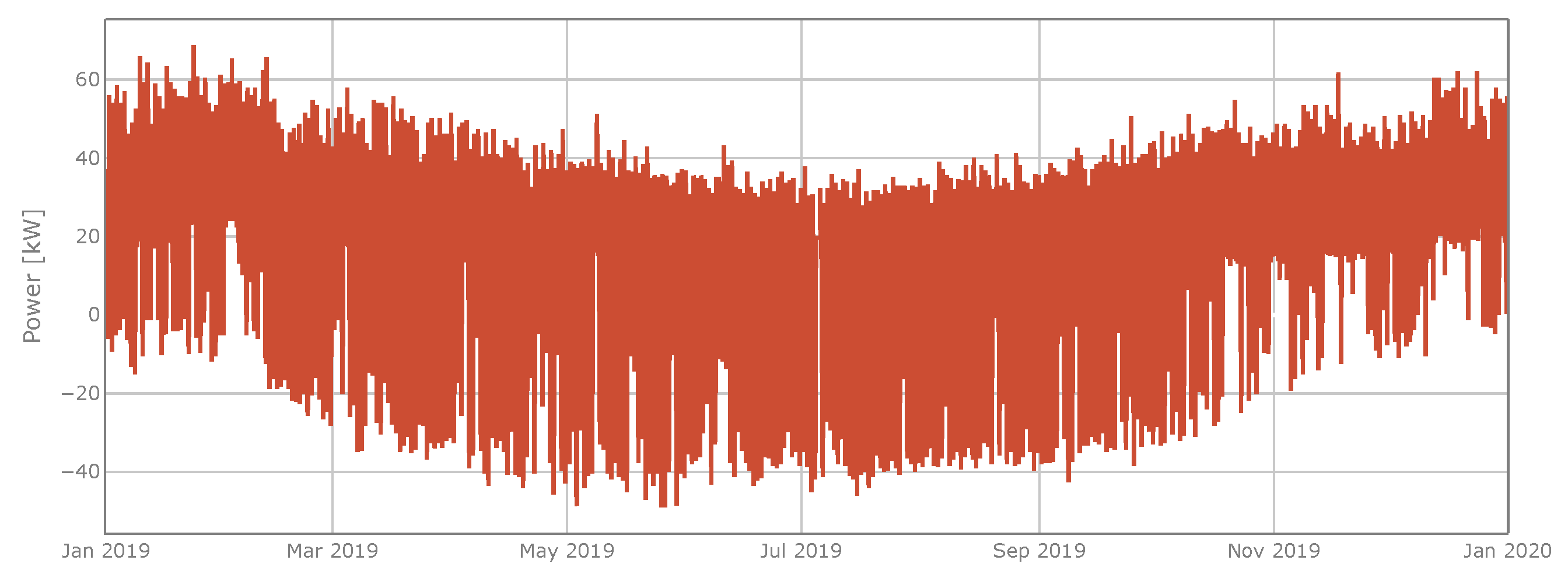
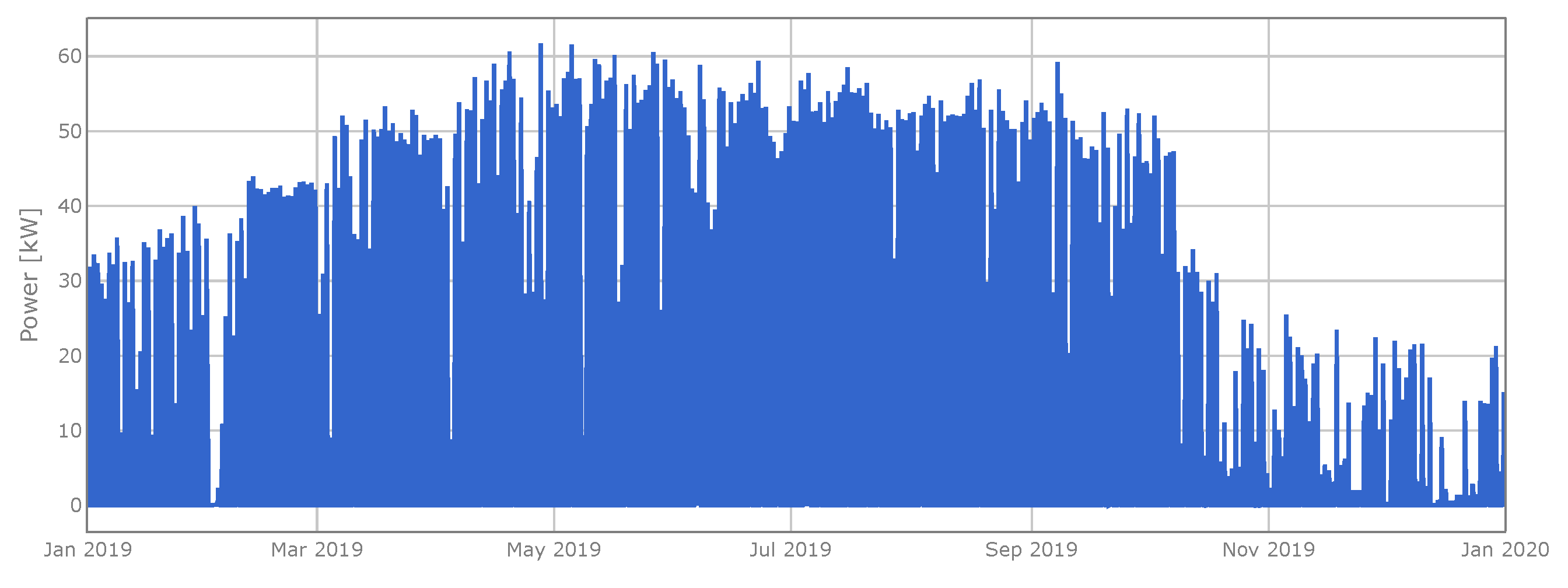

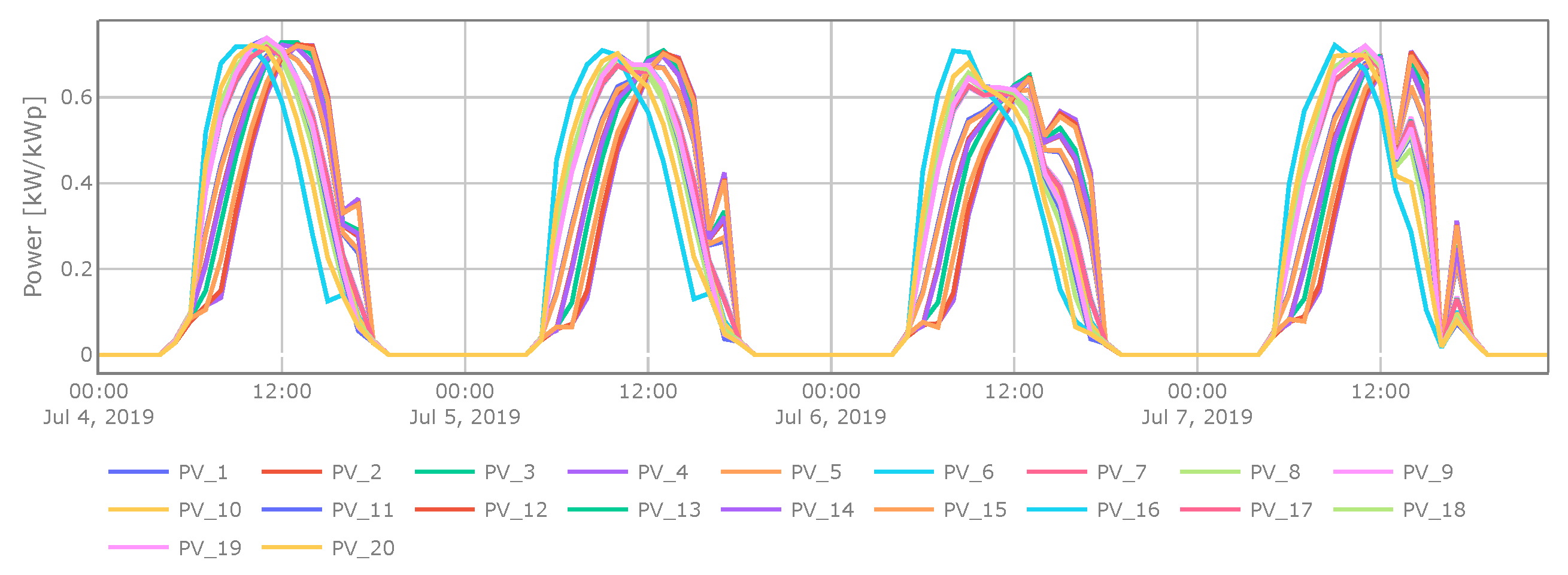

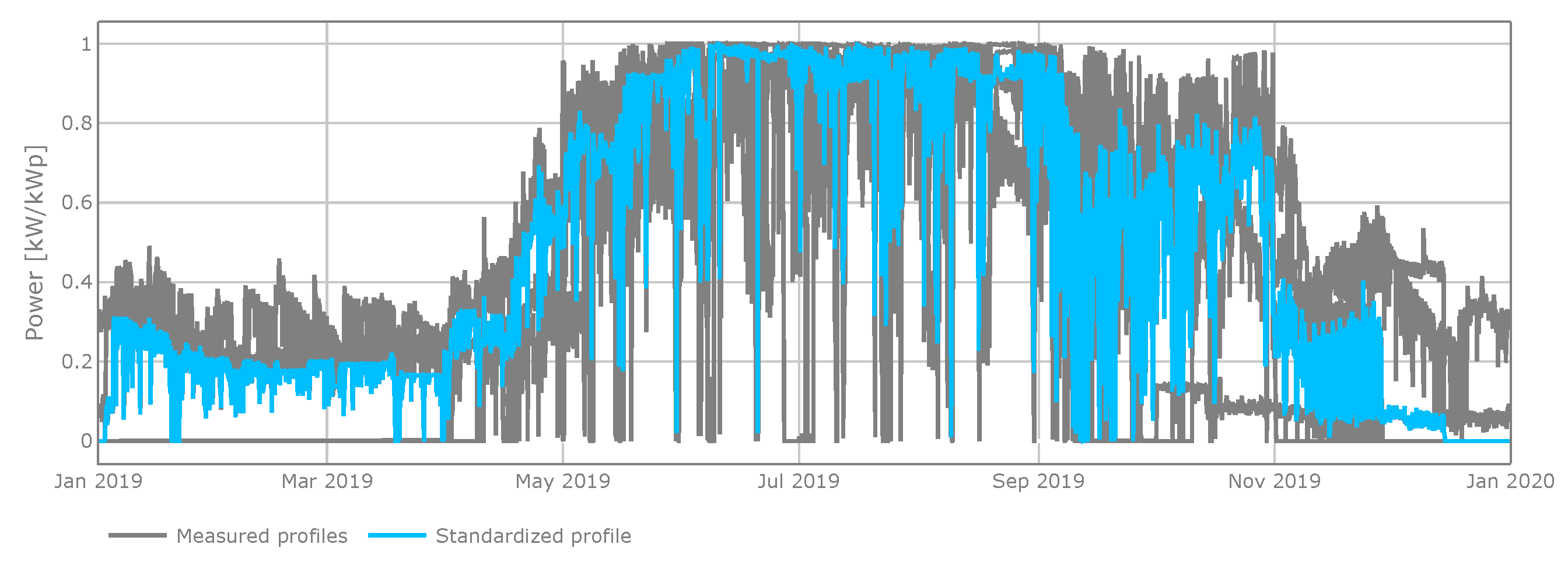



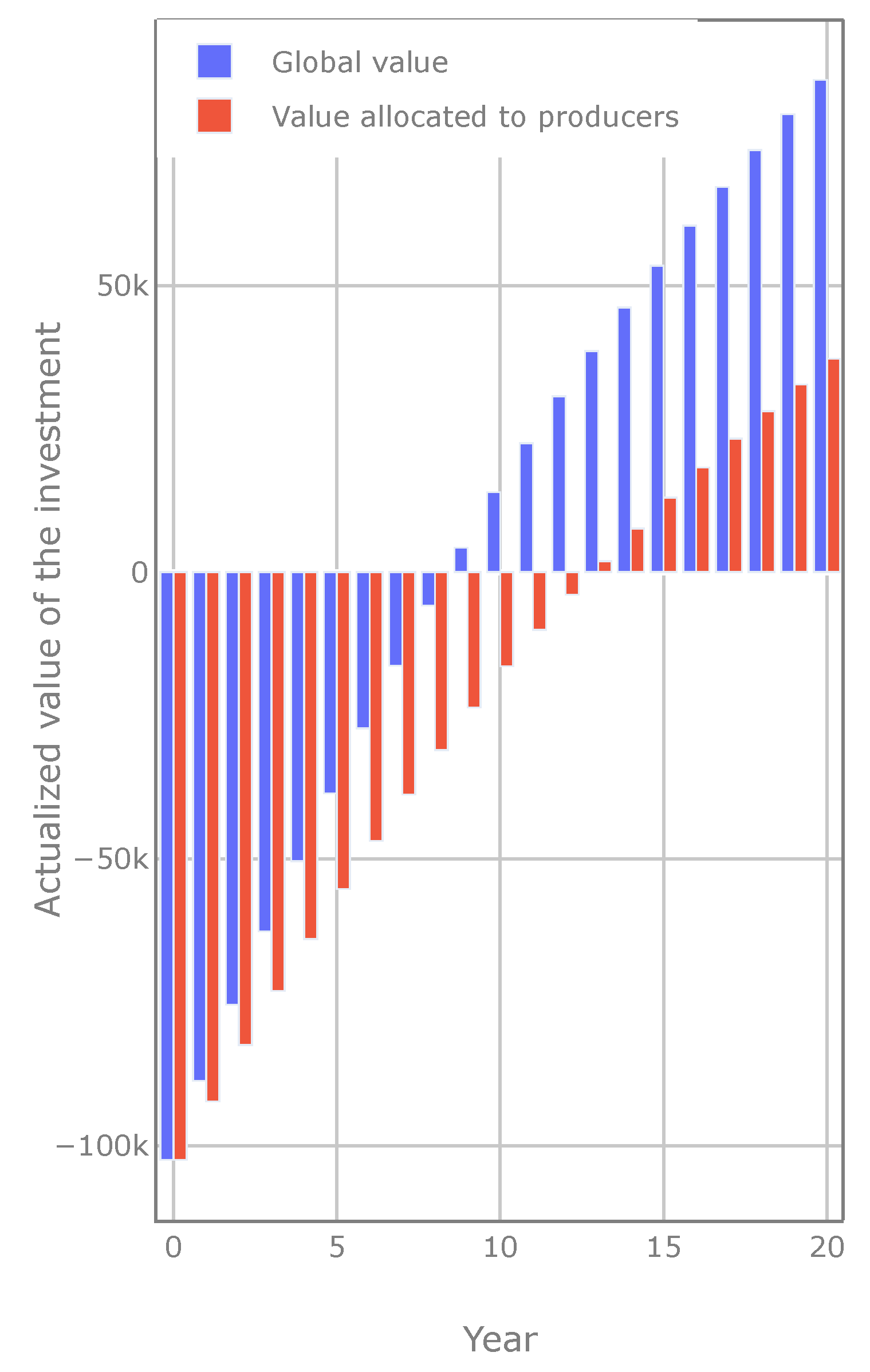

| Type of User | Number | Load [MhW/year] | |
|---|---|---|---|
| User | Total | ||
| 1 person resident | 32 | 1.1 | 35.2 |
| 2 people resident | 32 | 1.7 | 54.4 |
| 3 people resident | 19 | 2.3 | 43.7 |
| 4 people resident | 11 | 2.9 | 31.9 |
| 5 people resident | 3 | 3.5 | 10.5 |
| 6 people resident | 2 | 4.1 | 8.2 |
| Not resident | 15 | 0.642 | 9.6 |
| Other usages | 16 | 1.356 | 21.7 |
| Public lighting | 1 | 2.0 | 2.0 |
| Total | 131 | 217.2 | |
| ID_gen | ID_user | Pmax | Cost | Yearly O&M | Area | Orientation | Slope | Lon | Lat |
|---|---|---|---|---|---|---|---|---|---|
| [kW] | [€/kW] | [€/kW] | [m] | [°] | [°] | [°] | [°] | ||
| PV_1 | user_24 | 5 | 1400 | 40 | 60 | 49 | 10 | 7.330 | 45.756 |
| PV_2 | user_32 | 3 | 1400 | 40 | 30 | 50 | 20 | 7.329 | 45.757 |
| PV_3 | user_22 | 13 | 1400 | 40 | 158 | 45 | 30 | 7.329 | 45.757 |
| PV_4 | user_84 | 5 | 1400 | 40 | 55 | 61 | 40 | 7.329 | 45.756 |
| PV_5 | user_82 | 6 | 1400 | 40 | 73 | 57 | 10 | 7.329 | 45.757 |
| PV_6 | user_98 | 7 | 1600 | 40 | 82 | −24 | 20 | 7.329 | 45.756 |
| PV_7 | user_81 | 2 | 1600 | 40 | 25 | −19 | 30 | 7.329 | 45.756 |
| PV_8 | user_56 | 12 | 1600 | 40 | 139 | −20 | 40 | 7.329 | 45.756 |
| PV_9 | user_9 | 7 | 1600 | 40 | 82 | −30 | 10 | 7.330 | 45.756 |
| PV_10 | user_7 | 6 | 1600 | 40 | 76 | −27 | 20 | 7.330 | 45.756 |
| PV_11 | user_116 | 10 | 1800 | 40 | 120 | −23 | 30 | 7.329 | 45.756 |
| PV_12 | user_1 | 8 | 1800 | 40 | 101 | 57 | 40 | 7.330 | 45.756 |
| PV_13 | user_124 | 7 | 1800 | 40 | 87 | −36 | 10 | 7.330 | 45.755 |
| PV_14 | user_60 | 3 | 1800 | 40 | 36 | 53 | 20 | 7.329 | 45.755 |
| PV_15 | user_120 | 14 | 1800 | 40 | 165 | 68 | 30 | 7.331 | 45.755 |
| PV_16 | user_26 | 6 | 2000 | 40 | 69 | −60 | 40 | 7.331 | 45.755 |
| PV_17 | user_10 | 4 | 2000 | 40 | 42 | −38 | 10 | 7.332 | 45.755 |
| PV_18 | user_105 | 7 | 2000 | 40 | 80 | −34 | 20 | 7.331 | 45.755 |
| PV_19 | user_49 | 5 | 2000 | 40 | 60 | −18 | 30 | 7.329 | 45.756 |
| PV_20 | user_43 | 4 | 2000 | 40 | 50 | −36 | 40 | 7.329 | 45.755 |
| Hydro | user_132 | 20 | 4000 | 40 | ———— Specific profile for Hydro ———— | ||||
| Name | Value | Unit | Description |
|---|---|---|---|
| 5 | [€/user/year] | Administrative cost of the REC | |
| 110 | [€/MWh] | Incentive on shared energy | |
| 80 | [€/MWh] | Self-Consumption saving index | |
| 8.22 | [€/MWh] | Shared Energy saving index | |
| +2% | [%/year] | Yearly growth of the load profiles | |
| −2% | [%/year] | Yearly growth of the price profiles |
| Name | Value | Unit | Description |
|---|---|---|---|
| 400 | [€/kWh] | Storage investment | |
| 200 | [€/kWh] | Storage replacement cost | |
| 10 | [€/kWh] | Operation and maintenance | |
| 200 | [kWh] | Max storage size | |
| 2 | [h] | Energy to power ratio | |
| 0.95 | [-] | Storage eta CH | |
| 0.95 | [-] | Storage eta DIS | |
| 0.2 | [-] | Minimum state of charge | |
| 5000 | [-] | Max cycles |
Publisher’s Note: MDPI stays neutral with regard to jurisdictional claims in published maps and institutional affiliations. |
© 2020 by the authors. Licensee MDPI, Basel, Switzerland. This article is an open access article distributed under the terms and conditions of the Creative Commons Attribution (CC BY) license (http://creativecommons.org/licenses/by/4.0/).
Share and Cite
Moncecchi, M.; Meneghello, S.; Merlo, M. A Game Theoretic Approach for Energy Sharing in the Italian Renewable Energy Communities. Appl. Sci. 2020, 10, 8166. https://doi.org/10.3390/app10228166
Moncecchi M, Meneghello S, Merlo M. A Game Theoretic Approach for Energy Sharing in the Italian Renewable Energy Communities. Applied Sciences. 2020; 10(22):8166. https://doi.org/10.3390/app10228166
Chicago/Turabian StyleMoncecchi, Matteo, Stefano Meneghello, and Marco Merlo. 2020. "A Game Theoretic Approach for Energy Sharing in the Italian Renewable Energy Communities" Applied Sciences 10, no. 22: 8166. https://doi.org/10.3390/app10228166
APA StyleMoncecchi, M., Meneghello, S., & Merlo, M. (2020). A Game Theoretic Approach for Energy Sharing in the Italian Renewable Energy Communities. Applied Sciences, 10(22), 8166. https://doi.org/10.3390/app10228166






